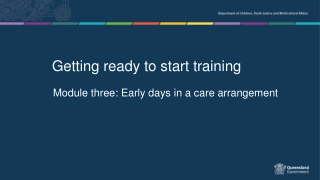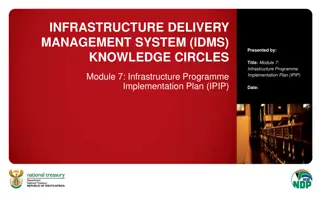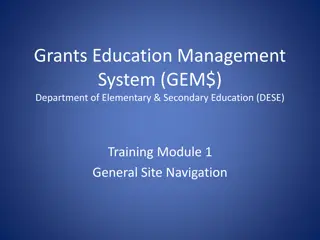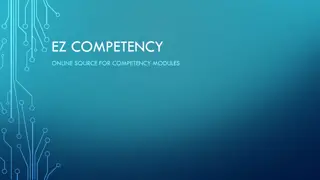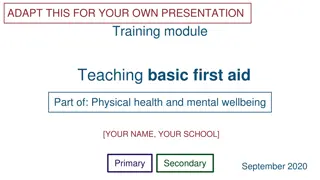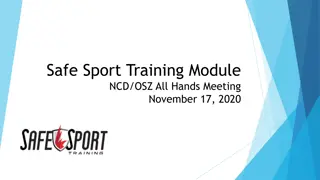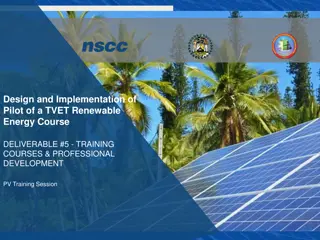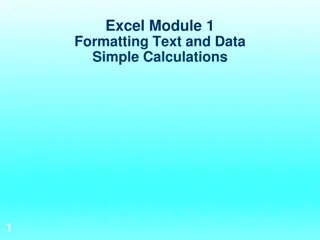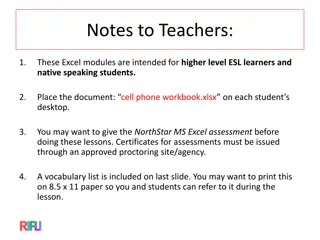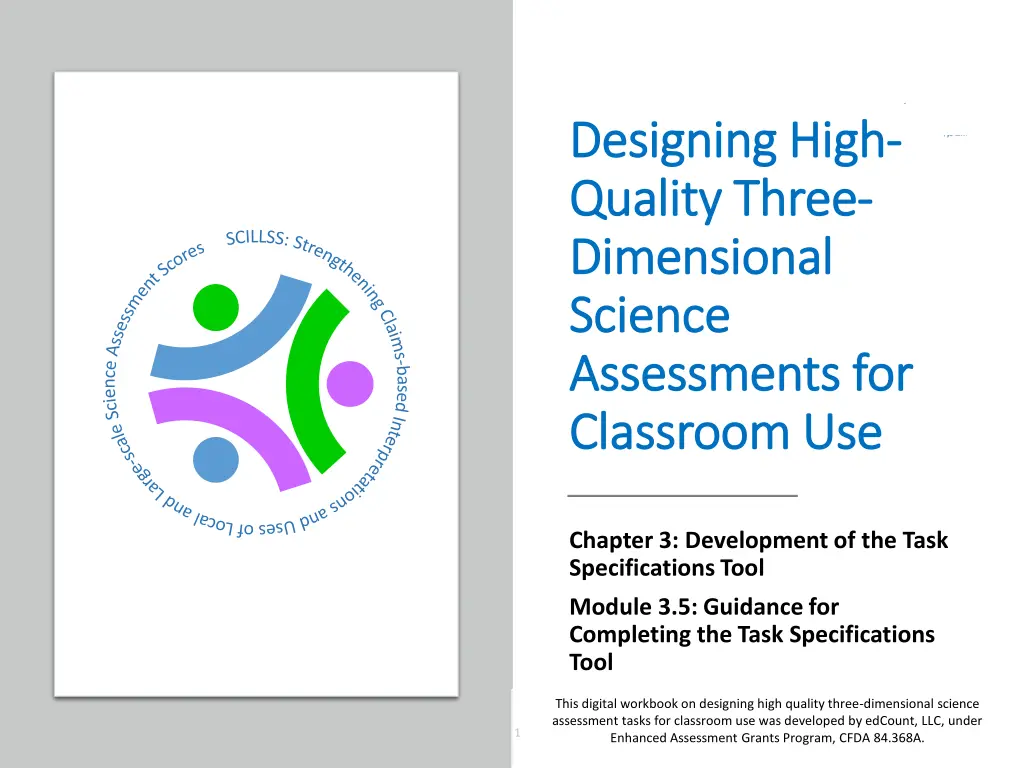
Developing Three-Dimensional Science Assessments: Task Specifications Tool
Explore the development of a task specifications tool for designing high-quality three-dimensional science assessments for classroom use. This guide provides guidance, outcomes, and strategies for completing the tool, along with key considerations for defining elements and assessing student demonstrations of learning. Get started by gathering essential resources and thinking critically about what needs to be measured. Use guiding questions and strategies to ensure the task specifications align with the expected knowledge, skills, and abilities (KSAs).
Uploaded on | 1 Views
Download Presentation

Please find below an Image/Link to download the presentation.
The content on the website is provided AS IS for your information and personal use only. It may not be sold, licensed, or shared on other websites without obtaining consent from the author. If you encounter any issues during the download, it is possible that the publisher has removed the file from their server.
You are allowed to download the files provided on this website for personal or commercial use, subject to the condition that they are used lawfully. All files are the property of their respective owners.
The content on the website is provided AS IS for your information and personal use only. It may not be sold, licensed, or shared on other websites without obtaining consent from the author.
E N D
Presentation Transcript
Designing High Designing High- - Quality Three Quality Three- - Dimensional Dimensional Science Science Assessments for Assessments for Classroom Use Classroom Use Chapter 3: Development of the Task Specifications Tool Module 3.5: Guidance for Completing the Task Specifications Tool This digital workbook on designing high quality three-dimensional science assessment tasks for classroom use was developed by edCount, LLC, under Enhanced Assessment Grants Program, CFDA 84.368A. 1
Module 3.5: Module 3.5: Guidance for Guidance for Completing the Task Completing the Task Specifications Tool Specifications Tool 2 2
Module 3.5 Outcomes Module 3.5 Outcomes Guidance for Completing the Task Specifications Tool To provide key considerations and strategies to complete the task specifications tool Guidance for Completing the Task Specifications Tool 3
Getting Started Getting Started 1. Gather key resources. i. A Framework for K-12 Science Education ii. State Science Content Standards iii.The NGSS iv.NGSS Evidence Statements v. NGSS Appendices E, F, and G vi.Unpacking Tool for the Selected PE vii.Task Specifications Tool Template 2. Think critically about what is to be measured when determining the KSAs. 3. Begin defining the elements of the Task Specifications Tool Template. 4
Getting Started Getting Started Defining the Elements Defining the Elements Student Demonstrations of Learning Knowledge, Skills, and Abilities Assessment Boundaries Work Products Aspects that can be varied Task Features 5
Guiding Questions for Completing the Guiding Questions for Completing the KSAs for the Task Specifications Tool KSAs for the Task Specifications Tool What ideas and skills are associated with a PE? What aspects from unpacking the dimensions can be combined to represent a construct to be measured (i.e., KSAs)? What KSAs are necessary for students to demonstrate in a task that reflect understanding of the PE? Are the KSAs consistent with the expectation of the PE? Are the KSAs consistent with the key aspects indicated in the unpacking tool? 6
Strategies for Completing the KSAs for Strategies for Completing the KSAs for the Task Specifications Tool the Task Specifications Tool Use the following strategies to complete the Task Specifications Tool: Consider the number of KSAs that are required to address the breadth and the dimensions represented in the PE. Consider if the specificity and range of the KSAs is sufficient to support the development of multiple tasks and questions/prompts within a task. Consider how the KSAs support the development of tasks that reflect how students will demonstrate learning. Consider how assessing the KSAs elicits sufficient evidence to make appropriate inferences about students learning. 7
Guiding Questions for Completing the SDLs Guiding Questions for Completing the SDLs and WPs for the Task Specifications Tool and WPs for the Task Specifications Tool What types of performances provide evidence that students have learned the KSAs? How can students demonstrate their learning? What types of responses or artifacts should students produce? What are the ways in which students can provide evidence of their learning (e.g., sense-making using the three dimensions)? How does the evidence reflect the selected KSAs? What are the kinds of behaviors and performances that show what students should know and be able to do after instruction? What are the questions, prompts, or situations that elicit evidence of students learning? 8
Strategies for Completing the SDLs and WPs Strategies for Completing the SDLs and WPs for the Task Specifications Tool for the Task Specifications Tool Use the following strategies to complete the task specifications tool: Consider important design decisions such as what information is presented to students, how it is presented, how students interact with the tasks, and how responses are provided. Review the KSAs to gain a complete understanding of what students are expected to demonstrate to provide evidence that they have learned one or more aspects of a PE. Consider and evaluate the types and variations of vehicles (i.e., work products) that are intended to contain observable evidence (e.g., a model, an argument, a description, a graph, a chart). Consider how the evidence elicited by the SDLs and WPs ensure that educators can make accurate inferences about student competencies. Consider how the SDLs and WPs with respect to the assessed KSAs will inform educator actions either to 1) continue with the instructional sequence as planned; or 2) adjust the design, delivery, and sequence of instruction. Consider how the SDLs and WPs will inform instructional decisions made at the individual student level, for a small group of students, or at the class level. 9
Guiding Questions for Completing the TFs, Guiding Questions for Completing the TFs, Aspects of the task that can be varied, and ABs Aspects of the task that can be varied, and ABs for the Task Specifications Tool for the Task Specifications Tool What are the features of task situations that allow students to demonstrate the degree to which expectations have been met? What are features of any assessment task that are required/necessary to appropriately measure one or more of the KSAs? What features allow for a range of tasks to be developed at varying levels of complexity, which, in turn, can affect the difficulty of the task? What features allow for a variation in the focus of the task? What features should be included and could be varied to address the characteristics of students, such as their interests, familiarity, and cultural identity, and their provided instruction? What information should not be assessed (i.e., related above grade- level ideas and skills)? 10
Strategies for Completing the TFs, Strategies for Completing the TFs, Aspects of the task that can be varied, task that can be varied, and ABs for the Task and ABs for the Task Specifications Tool Specifications Tool Use the following strategies to complete the Task Specifications Tool: Consider the necessary task features for addressing a KSA or KSAs for the selected PE. Consider the range of phenomena or design problems that might be included in a task scenario or context. Consider how to promote engagement regarding students interests, familiarity (e.g., local or regional topics, opportunities for instruction), and cultural identities. Consider the reading level, the amount of reading/text, the clarity and conciseness of the text, the use of graphics, symbols, and equations, etc., and how these each might be varied to ensure tasks are accessible to all students. Reference the Clarification Statement in the PE as appropriate. Review the Assessment Boundaries in the PE as appropriate. Aspects of the 11
Task Specifications Task Specifications Tool Development Tool Development Ready to develop the task specifications tool? Access these grade or grade-band specific documents: Completed Unpacking Tool A Framework for K-12 Science Education Next Generation Science Standards NGSS Evidence Statements NGSS Appendices E, F, and G SCILLSS Model Task Specifications Tools Guidance to Complete Activities Task Specifications Tool Task Specifications Tool Template Complete the Task Specifications Tool for your grade or grade band independently, with a partner, or in a small group. 12
Resources and Resources and Additional Additional Information Information 13
SCILLSS Glossary SCILLSS Glossary Please refer to the SCILLSS Glossary for operational definitions of terms used. 14
Resources Resources In the Web Links pod, you can find the following resources: A Framework for K-12 Science Education Next Generation Science Standards NGSS Evidence Statements Appendix E: Disciplinary Core Idea Progressions Appendix F: Science and Engineering Practices Appendix G: Crosscutting Concepts In the Resources pod, you can find the following resources: Task Specifications Tool Template Guidance to Complete Activities Task Specifications Tool SCILLSS Model Task Specifications Tools 15
References References National Research Council. (2012). A Framework for K-12 Science Education: Practices, Crosscutting Concepts, and Core Ideas. Washington, DC: The National Academies Press. https://doi.org/10.17226/13165. 16


